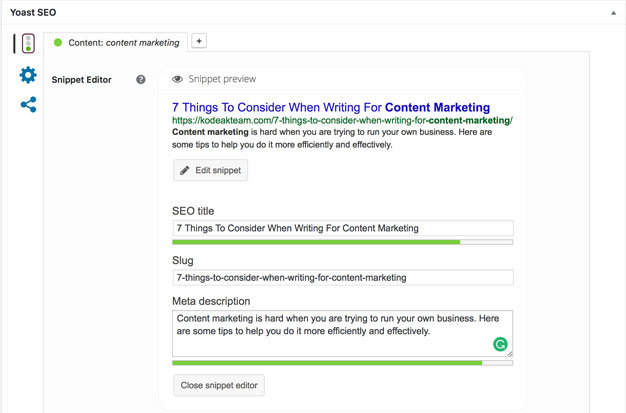Writing content for your website, much like this blog post you are about to dive into, is a pain in the ass. No beating around the bush here. It is just a flat-out, albeit necessary, hassle that you were told by your internet marketing manager that you had to do if you wanted to move up the Search Engine Results Pages (SERPs). After all, content marketing generates 3 times as many leads as traditional outbound marketing, but at a cost of 62% less. So why wouldn’t you take the time to write an article or two a week? Well, probably because you are busy running a company. Thankfully, I write code and SEO better than I write articles, but I am still here, taking my own medicine, writing this article for you. The fact is, nobody knows your business and industry better than you, so why would you want anyone else writing content on your behalf?
We always advise our clients to write for themselves or at least delegate that role to someone within their company. That said, we understand the toll that running your own small business can take on you and your time. There is no denying that you will have to sacrifice the time from some other area to make this work. For those unwilling to make that adjustment, you can hire freelance writers from sites like Fiverr and Constant-Content to write for you. Then you can simply put your spin on it and then we’ll mark it up for SEO and post it. The risk is that your message may not be conveyed with your passion for what you do when you hire a freelance writer. Still, something is better than nothing if you need to get more traffic to your website.
Your blog is a great way for your users to find more information about what you do in a longer form than what you would regularly provide on the main pages of your website. Mainly, each blog acts as another entry point to your website that has a focused topic that a user is searching for, giving you an opportunity to convert a reader into a customer. Here are some tips on writing content for your blog that other people will actually want to read.
Pick a topic your customers often ask for clarification on
Due to the gradual degradation of the human’s attention span over time, your main website pages should have short and concise content. You want to describe what you do, why you do it, and why your customers should choose you over your competitors in as few sentences as possible while giving enough information for your visitor to make a decision to contact you. But there are still plenty of consumers who simply want more information, so you have to cater to them as well. The best place to do that is through your blog. And the best topics to start with are those that answer your most frequently asked questions. In most cases, those are typically highly searched topics, so this will help boost your company’s visibility in the SERPs by creating more pages with focused topics that you can rank for. Every page that you rank for in the SERPs is just more brand recognition, more access your potential customers have to reach you, and more chances to convert. This will also create the opportunity to build a good internal linking structure which will also boost your overall page rank. Make sure you stay on topic as you write and wrap up the piece with a clear conclusion to your thoughts.
Make a list when possible
People love lists. The organization and specificity of what the reader is in store for with a list-titled article let your brain know exactly what it is going to get. Plus, many people like to get straight to the information they are looking for if it is a subject that they are familiar with. Lists provide a short title describing the paragraph below it, allowing your users to skim to the point they want to read more about. Make sure to use a title that indicates to your readers that they are about to read a listed article, e.g., “How to ___ in 5 easy steps” or “The 7 best ____”. Articles with numbered list titles are clicked through 71% more than any other style of written content.
Provide facts and statistics to support your claims

One of your content marketing goals in writing a blog is to build trust with your customers by showing that you know what you are talking about. Don’t expect them to trust you right out of the gates though. Help secure your spot as an authority in your industry by citing reputable sources with facts and statistics that back up your claims and opinions. Infographics are highly consumable if you have the ability to sprinkle one of those in every once in and while. You can use sites like Canva to make them up pretty quickly and it can bring your article to another level visually. Pages with infographics typically get 200% more likes on Facebook and 12% more click-through traffic on landing pages. If you want another stat, ok… most people will only retain about 10% of information from a text-only page 3 days later, but when that information is paired with a relevant image, the retained information jumps to 65% 3 days later.
Include images to help your points and to break up content
Just like your text content, you should have original images to complement your article. Stock images will work as well when you can’t come up with some original photography, but original images will always be more received by a reader than stock images. At a minimum, you will need a featured image to go with the topic of your article. This will be the image that will be seen when shared on social media or in any other rich format. Images within the text content are highly recommended as well. People would rather read something that is beautifully designed over something that is plain. In fact, 38% of users will leave a website with poor content or layout. Since 90% of the information we absorb is visual, it is important to associate a relevant image with your text content so that your reader can remember it, and you, better later on.
Make it easy to share on any social media
Place social sharing buttons at the top, bottom, and/or sticky somewhere on the screen so your reader can easily share your post with their friends should the urge arise. Spreading your posts throughout the internet is at the heart of content marketing and there is no bigger sea than social media. If your post is informative or riveting enough, people will share it. Don’t make them look for it or copy the link to post. Anticipate the share. Make sure that you have sized images specifically for each platform as well. Check out this link for all your social platform’s image sizing suggestions. If you want to keep it simple, you can size it to fit Twitter as a default (1024X512px). Social is a great way, maybe even the best way, to get a good jump on traffic while you build your Tucson SEO campaign.
Optimize the post for SEO
Here we go. If you don’t do this, it is all for nothing really. Do the keyword research based on the topic of your post. Look for good long-tail keywords, with decent search volume, and low competition. Think about user intent when selecting your target keywords also. What kind of visitor are you looking for to read your post? Once you have your target keyword(s) ready, make sure to use it in your meta title, description, alt tags, header tags, and of course your content, but don’t overdo it.
Write for your reader, not for search engines. Google will discount you for “keyword stuffing” if you just shove your keyword all over your post. Plus, that never reads well and may confuse the reader. Build your internal linking structure with anchor text using target keywords from your other pages and link to them throughout your content to help them rank better. There is far more to on-site SEO than this of course, but this is a good start and foundation for the do-it-yourselfer. There are tools that make writing your SEO easier like Yoast for WordPress.

End with a call to action
You got them to your post and they even read the whole thing. You have their attention, now what? Time to convert them! Call them to action! Go back to point number one and think about the reader who just read your post. Why did they read it? What would be a logical next step for them? Do they want more information? If so, give them the opportunity to contact you. Traditionally, you would use a short form to capture the lead or steer them to make a call to you. There are also some newish developments in chatbots and various forms of ‘dumb AI’ that can make an easier barrier to cross for your reader to contact you rather than leaving their personal information right away.
But maybe you would rather them visit one of your main pages or your portfolio or product pages. Maybe you just want them to read another article. Whatever it is, take advantage of having their attention and make every effort to monetize their visit to your site. Every website will have different goals with the inbound traffic from their blog, so make sure that you know what your strategy is going to be before you push your articles to your potential audience.
Conclusion
Content marketing can do wonders for your online presence. Building brand recognition, generating traffic to your site, and the opportunity to capture leads, along with the many SEO benefits that come along with it, it’s hard to deny that a good content marketing strategy shouldn’t be a part of your marketing plan. Let us know in the comment section below if you have implemented a content marketing strategy and how it has helped your business so far.









